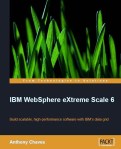As already stated I’ve been invited to review WebSphere eXtreme Scale book from Packt Publishing. The book is an excellent choice for anyone interested in adopting WebSphere eXtreme Scale in a solution.
The book starts on chapter one with basic concepts about a data grid and ends up with a hello world like application.
On chapter two it starts to take a deeper dive into WebSphere eXtreme Scale concepts. The first one explored is the ObjectMap API which is composed by the ObjectMap and the BackingMap objects.
Chapter three is the one that specially took my attention since it presented me a feature I had no clue eXtreme Scale had: a JPA like implementation. This is one of the things that makes eXtreme Scale such a nice tool. By now you will probably be thinking: “but what is the difference of having this and eXtreme Scale acting as an ORM cache?”. In fact there’s a great deal of differences – first one: on an ORM solution you’re caching data that when “hydrated” (as Hibernate calls it – this article explains something about hibernate 2nd level cache) becomes objects, so, you still have the time lapse and the memory losses derived from hydrating objects on each request. Another major advantage is that ORM caches are usually invalidated upon some update scenarios which leads to reload of data.
Chapter four covers how to integrate a data grid with a database store. As the book states you’d need to integrate with a database backend to provide a richer and wider set of tools for report generation, to integrate with legacy application that still interact with database, etc.
Chapter five is dedicated to handling increased load. If you thought: “Do I still need to care about load increase?” the answer is “YES! For Sure!”. All and every software needs to be proper configured for increased load, by no means eXtreme Scale would be an exception and this chapter covers important topics of performing planning for increased load.
Chapter six is devoted to keeping data available, so now it focus on replication and other important points.
Chapter seven (which is also freely available online) presents a rather different pattern of performing tasks in a distributed application – pushing the operation instead of pulling the data.
Chapter eight is dedicated to present some common patterns when using a data grid.
Chapter nine covers some facilities for Spring integration.
And finally chapter ten covers a complete example of a project that is built open eXtreme Scale.
One thing I’d like to see on the books next edition is the ability of replacing WebSphere’s Application Server DynaCache with an eXtreme Scale cache implementation. But it is no surprise for me that this was missing on book since they (the book and this feature) were released almost at the same time, invalidating any possibility of this being covered on the book.
In summary: this is a book I really recommend for anyone interested in picking a data grid solution for Java. It is also more recommended if you are already inclined to use an IBM solution and stick with eXtreme Scale.



